Force v. Size
Back from Canoecopia which had huge attendance. Unfortunately, I didn't bump into a lot of the folks I had looked forward to seeing. I will be posting pics and comments soon.Meanwhile, I have been driving myself nuts while mulling over an issue around boat size and speed. For starters, we all agree that a longer boat (all else being equal) can go faster than a shorter one. So far so good. In addition, we know that that longer boat will need more horsepower (muscle) to hit those higher speeds. Correct? Here's where the waters get muddy.
Say a paddler is capable of putting out, oh say, 5 units of power. If we put this paddler into a long boat that needs 6 units of power to hit top speed, he will fall short. Okay? Now, let's put him in a slightly shorter boat that tops out with only 5 units of applied power. Hurray, the paddler hits hull speed in that boat.
The question is, in which boat can he go the fastest?
Now, I have a headache.
Paddle safe...
DS










16 comments:
Just for fun, try paddling a surfski once and then ask yourself the question again.
Silbs, there are published drag numbers for some boats.
So it would appear that if a person can only output a max of 5 units and the longer boat needs 6 (higher drag) to go faster, would it be safe to conclude that that person would go faster in a shorter boat?
I am inclined to think so.
From personal observations I noticed that if a paddler has low output (due to fitness or technique) he/she will not go faster in a longer kayak.
Russ, I'm not sure I get your point. Can you say more?
add th fact that over great distances, comfort comes into play, the ability to get to gear easily and efficiently... the ability to stay in the boat for long periods of time... exit the kayak...enter the canoe. wup wup now i have your attention!! :-)
Sorry missed you at Canoecopia!
My gut reaction is the same as Gnarlydog, and the Captain brings up another point. In the bigger boat the paddler would (I am guessing) tire more quickly than if he'd been in the slightly shorter one.
I'd rather go far than fast. I guess I'm kind of a hare and tortise kind of guy. Gotta make it down next year I guess.
Too late, DaveO. I marked you absent, and that is on your permanent record :)
The longer hull is faster for this paddler if its top speed is greater than 6/5 the top speed of the shorter hull.
Leslie, please repost as your comment got lost in the ether.
so, does this mean you are in the market for another boat? If so, you are going to have bigger problems than just a headache. ;-)
The theory that the shorter boat is optimal, doesn't allow for improved fitness or improved stroke. With the longer hull can come more potential speed. so you actually might be traveling close to the same speed for effort...but with the longer hull....you still have potential to go. With the shorter one, Your at it's wall
Leslie, who has a science background, offered: The longer boat is faster for this paddler if its top hull speed is greater than 6/5 the speed of the shorter boat. (Assume linear speed/output relationship.)
No, JB, not another boat...at least, not this week.
thanks, Roy. Good points. Good seeing you at Canoecopia.
There are a lot of variables in the equation, including paddler's weight, boat weight, length, hull design, etc. A longer boat isn't always the faster boat, but it has a faster "theoretical top hull speed." Assuming the paddler is able to comfortably output the same amount of thrust in each boat, it comes down resistance.
For example, if our paddler weighs 160 and the boat weighs 40, these are the resistance numbers of Brian Schulz F1 (14'2") design (http://www.capefalconkayak.com/f1.html). Maximum hull speed for the F1 is 5.19knots (Hull Speed = 1.34*(LWL)^1/2)
0.50 0.06
1.00 0.21
1.50 0.45
2.00 0.76
2.50 1.14
3.00 1.58
3.50 2.20
4.00 3.12
4.50 4.65
5.00 7.09
If we put this boat up against my cedar strip Siskiwit Bay (17') design (http://www.nessmuking.com/articles/free-siskiwit-bay-kayak-plans-for-backyard-builders/), you can see that at almost every speed, the Bay is more efficient.
0.50 0.06
1.00 0.20
1.50 0.43
2.00 0.74
2.50 1.11
3.00 1.54
3.50 2.08
4.00 2.85
4.50 4.16
5.00 6.13
Sea Kayaker Magazine claims that a fit paddler can maintain speed against 3 pounds of drag (http://www.seakayakermag.com/PDFs/Kayak_Reviews_Info_0609.pdf). So, if we assume that our paddler can cruise all day against 3 pounds of drag, we actually see that the longer kayak is faster for this paddler.
Looking at the Chatham 16:
0.50 0.06
1.00 0.21
1.50 0.45
2.00 0.76
2.50 1.14
3.00 1.59
3.50 2.19
4.00 3.13
4.50 4.77
5.00 7.28
We see that at lower speeds the shorter F1 is about as efficient and at higher speeds is more. So, in this case, our paddler who can paddle against 3 pounds, makes the F1 and Chatham go the same speed even though the Chatham's hull speed is 5.36 knots.
If we add more weight in cargo to these boats, the numbers may tell a different story. There really is no easy rule to apply.
Hey, Bryan, thanks for the scholarly post. At the end of the day, it is a complex issue, as I am learning. Then there is the whole issue of personal likes and the lot. Good stuff. Thanks
You're welcome. I agree that personal preference is huge even when it comes to hull speed and resistance.
For example, I don't like a boat that feels like I'm up against a wall when I paddle harder. When I paddle my Explorer and I'm cruising comfortably in the 4 to 4.2 knot range I'm fine, but if I try to push to the 4.5 knot range, I feel a sudden wall that takes a disproportionate amount of power to hit. In my Romany, which is probably slower at each level of output doesn't have that feel, so I enjoy paddling it more even if it's a slower kayak.
Post a Comment